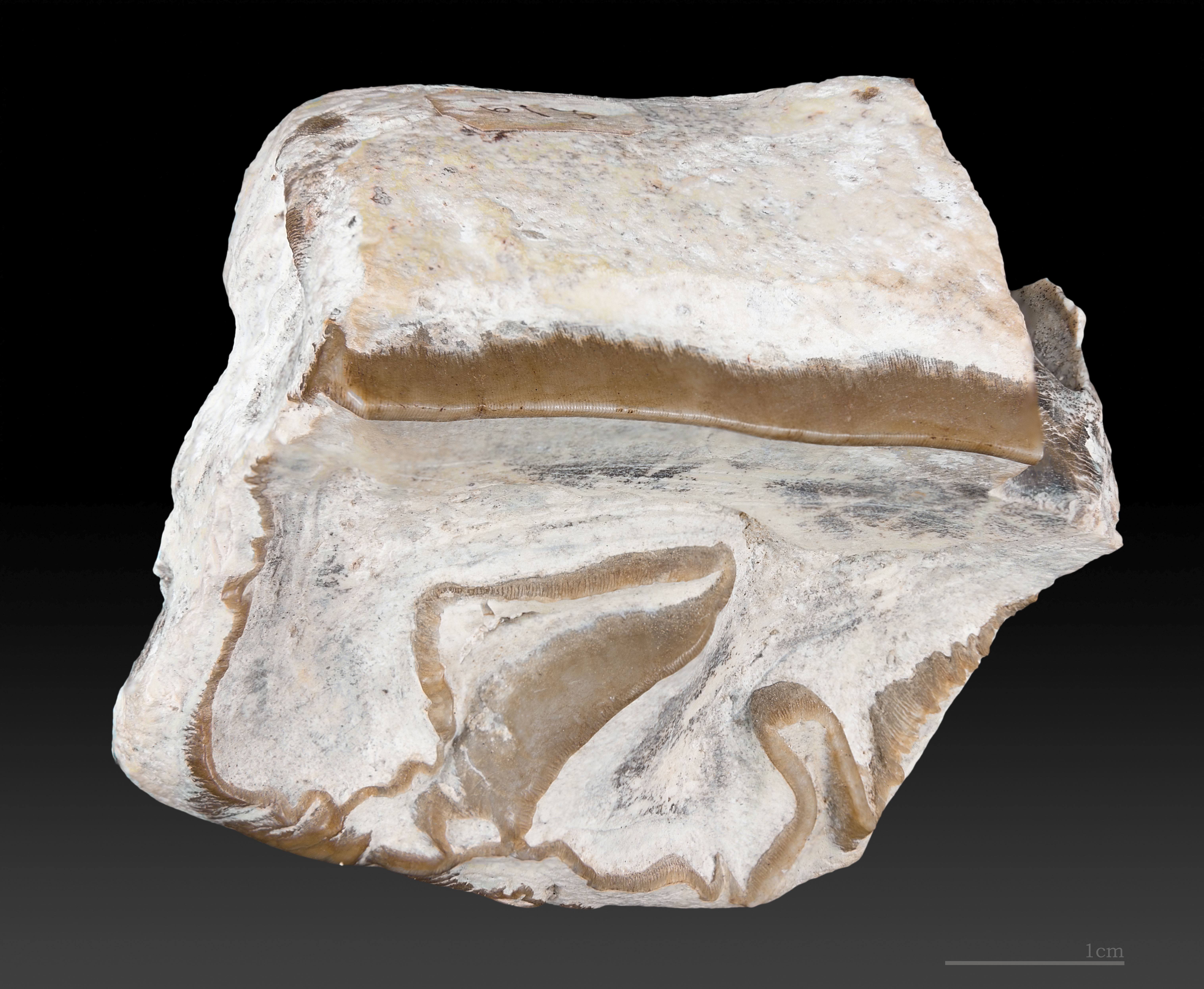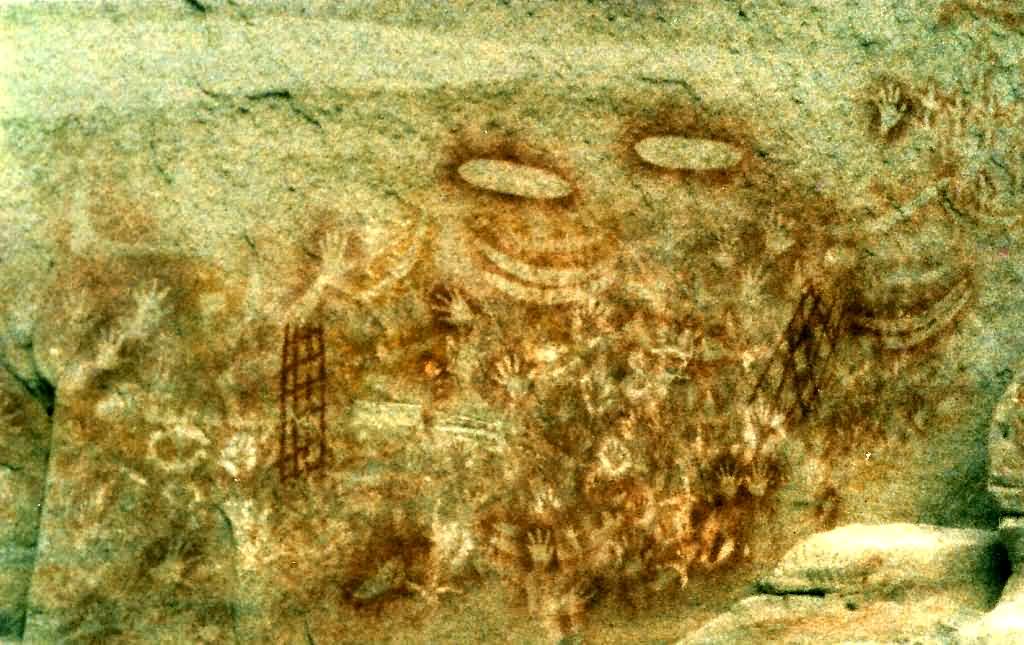|
Baru Wickeni
''Baru'', sometimes referred to as the cleaver-headed crocodile, is an extinct genus of Australian mekosuchine crocodilian. Its fossils have been found from various Late Oligocene and Miocene localities from across the Northern Territory and Queensland, indicating that ''Baru'' was a common genus during the late Paleogene and early Neogene. Three species are recognized, ''B. darrowi'', ''B. iylwenpeny'', and ''B. wickeni''. ''Baru'' was a large and powerful mekosuchine with an incredibly deep and robust skull and long teeth with compressed crowns that in the case of ''Baru darrowi'' are furthermore adorned with minute serrations. At a length of around , it was among the largest crocodilians native to Australia at the time and the largest predator of its ecosystem. With dorsally oriented nostrils and eyes and a poor range of head movement, as well as its fossils being associated with freshwater environments, ''Baru'' is generally interpreted to have been a semi-aquatic ambush hunt ... [...More Info...] [...Related Items...] OR: [Wikipedia] [Google] [Baidu] |
Late Oligocene
The Chattian is, in the geologic timescale The geologic time scale or geological time scale (GTS) is a representation of time based on the rock record of Earth. It is a system of chronological dating that uses chronostratigraphy (the process of relating strata to time) and geochron ..., the younger of two age (geology), ages or upper of two stage (stratigraphy), stages of the Oligocene epoch (geology), Epoch/Series (stratigraphy), Series. It spans the time between . The Chattian is preceded by the Rupelian and is followed by the Aquitanian (stage), Aquitanian (the lowest stage of the Miocene). Stratigraphic definition The Chattian was introduced by Austrian palaeontologist Theodor Fuchs in 1894. Fuchs named the stage after the Chatti, a Germanic peoples, Germanic tribe.Berry, Edward W"The Mayence Basin, a Chapter of Geologic History" ''The Scientific Monthly'', Vol. 16, No. 2, February 1923. pp. 114. Retrieved March 18, 2020. The original type locality (geology), type l ... [...More Info...] [...Related Items...] OR: [Wikipedia] [Google] [Baidu] |
Paratype
In zoology and botany, a paratype is a specimen of an organism that helps define what the scientific name of a species and other taxon actually represents, but it is not the holotype (and in botany is also neither an isotype (biology), isotype nor a syntype). Often there is more than one paratype. Paratypes are usually held in museum research collections. The exact meaning of the term ''paratype'' when it is used in zoology is not the same as the meaning when it is used in botany. In both cases however, this term is used in conjunction with ''holotype''. Zoology In zoological nomenclature, a paratype is officially defined as "Each specimen of a type series other than the holotype.", ''International Code of Zoological Nomenclature'' In turn, this definition relies on the definition of a "type series". A type series is the material (specimens of organisms) that was cited in the original publication of the new species or subspecies, and was not excluded from being type material ... [...More Info...] [...Related Items...] OR: [Wikipedia] [Google] [Baidu] |
University Of New South Wales
The University of New South Wales (UNSW) is a public research university based in Sydney, New South Wales, Australia. It was established in 1949. The university comprises seven faculties, through which it offers bachelor's, master's and doctoral degrees. Its main campus is in the Sydney eastern suburb of Kensington, from the Sydney central business district (CBD). Its creative arts school, UNSW Art & Design (in the faculty of Arts, Design and Architecture), is located in Paddington and it has subcampuses in the Sydney CBD and several other suburbs, including Randwick and Coogee. It has a campus at the Australian Defence Force military academy, ADFA in Canberra, Australian Capital Territory. It has research stations located throughout the state of New South Wales. It is one of the founding members of Group of Eight, a coalition of Australian research-intensive universities and a member of Universitas 21, a global network of research universities. It has international ... [...More Info...] [...Related Items...] OR: [Wikipedia] [Google] [Baidu] |
Anmatyerr
The Anmatyerr (also spelt Anmatyerre, Anmatjera, Anmatjirra, Amatjere and other variations) are an Aboriginal Australian people of the Northern Territory, who speak one of the Upper Arrernte languages. Language Anmatyerr is divided into Eastern and Western dialects, both dialects of Upper Arrernte. The linguist Jennifer Green has been key to documenting the Anmatyerr language and the anthropologist Jason M. Gibson has written about Anmatyerr history, language and ceremonial practice. Country In 1974 the traditional lands of the Anmatyerr people in N.B. Tindale's ''Aboriginal Tribes of Australia'' were described as covering an area of . He specifies its central features as encompassing the Forster Range, Mount Leichhardt (''Arnka''), Coniston, Stuart Bluff Range to the east of West Bluff; the Hann and Reynolds Ranges (''Arwerlt Atwaty''); the Burt Plain north of Rembrandt Rocks and Connor Well. Their eastern frontier went as far as Woodgreen. To the northeast, their borders ... [...More Info...] [...Related Items...] OR: [Wikipedia] [Google] [Baidu] |
Waite Formation
Waite may refer to: People and fictional characters * Waite (name), a list of people and fictional characters with the surname or given name * An alternative spelling for Wait (musician) Other uses * Waite, Maine, a town in the United States * Waite Research Precinct, located in the Adelaide suburb of Urrbrae, South Australia ** Waite Campus of the University of Adelaide, located within the Waite Research Precinct * Electoral district of Waite Waite is a single-member Electoral districts of South Australia, electoral district for the South Australian House of Assembly. Named after Peter Waite (philanthropist), Peter Waite, a 19th century entrepreneur and philanthropist, it covers 75.4 ..., a state electoral district in South Australia See also * * Wait (other) {{disambiguation, geo ... [...More Info...] [...Related Items...] OR: [Wikipedia] [Google] [Baidu] |
Alice Springs
Alice Springs () is a town in the Northern Territory, Australia; it is the third-largest settlement after Darwin, Northern Territory, Darwin and Palmerston, Northern Territory, Palmerston. The name Alice Springs was given by surveyor William Mills (surveyor), William Whitfield Mills after Alice, Lady Todd (), wife of the telegraph pioneer Sir Charles Todd (pioneer), Charles Todd. Known colloquially as The Alice or simply Alice, the town is situated roughly in Australia's Geographical centre, geographic centre. It is nearly equidistant from Adelaide and Darwin, Northern Territory, Darwin. The area is also known locally as to its Indigenous Australians, original inhabitants, the Arrernte people, Arrernte, who have lived in the Central Australian desert in and around what is now Alice Springs for tens of thousands of years. Alice Springs had a population of 33,990 as of June 2024. The town's population accounts for approximately 10 percent of the population of the Northern Terr ... [...More Info...] [...Related Items...] OR: [Wikipedia] [Google] [Baidu] |
Alcoota
__NOTOC__ The Alcoota Fossil Beds are an important paleontological Lagerstätte in the Northern Territory of Australia located on Alcoota Station in the locality of Anmatjere about north-east of Alice Springs in the Central Australia region. It is notable for the occurrence of well-preserved, rare, Miocene vertebrate fossils, which provide evidence of the evolution of the Northern Territory’s fauna and climate. The Alcoota Fossil Beds are also significant as a research and teaching site for palaeontology students. The Alcoota deposit is a series of intermittently interconnected lakes within a large basin. Evidence suggests that the concentration of fossils is due to a phenomenon called ‘waterhole-tethering’: During dry periods, animals concentrated in the immediate area of the continually shrinking, spring-fed lake, resulting in the death of many animals. The Alcoota and Bullock Creek fossil faunas provide evidence that aridification was in progress in northern Aust ... [...More Info...] [...Related Items...] OR: [Wikipedia] [Google] [Baidu] |
Paul Darrow
Paul Darrow (born Paul Valentine Birkby; 2 May 1941 – 3 June 2019) was an English actor and writer. He became best known for playing Kerr Avon in the BBC science fiction television series ''Blake's 7'' between 1978 and 1981. His many television roles included two appearances in another BBC science fiction series, ''Doctor Who'', playing Captain Hawkins in '' Doctor Who and the Silurians'' (1970) and Tekker in '' Timelash'' (1985). He was also the voice of "Jack" on independent radio stations JACKfm and Union JACK, whose lines included dry-witted comments pertaining to current events. Early years Darrow was born Paul Valentine Birkby in Chessington, Surrey, on 2 May 1941. He received his formal education at Haberdashers' Aske's Boys' School, before studying at the Royal Academy of Dramatic Art. Whilst at RADA, he shared a flat with fellow actors John Hurt and Ian McShane. Career Darrow worked extensively in theatre and television. His television appearances include: ... [...More Info...] [...Related Items...] OR: [Wikipedia] [Google] [Baidu] |
Baru Distribution
''Baru'', sometimes referred to as the cleaver-headed crocodile, is an extinct genus of Australian mekosuchine crocodilian. Its fossils have been found from various Late Oligocene and Miocene localities from across the Northern Territory and Queensland, indicating that ''Baru'' was a common genus during the late Paleogene and early Neogene. Three species are recognized, ''B. darrowi'', ''B. iylwenpeny'', and ''B. wickeni''. ''Baru'' was a large and powerful mekosuchine with an incredibly deep and robust skull and long teeth with compressed crowns that in the case of ''Baru darrowi'' are furthermore adorned with minute serrations. At a length of around , it was among the largest crocodilians native to Australia at the time and the largest predator of its ecosystem. With dorsally oriented nostrils and eyes and a poor range of head movement, as well as its fossils being associated with freshwater environments, ''Baru'' is generally interpreted to have been a semi-aquatic ambush hunt ... [...More Info...] [...Related Items...] OR: [Wikipedia] [Google] [Baidu] |
East Arnhem Region
The East Arnhem Region is a local government area of the Northern Territory, Australia, governed by the East Arnhem Regional Council. Situated in Arnhem Land in the far north-eastern corner of the Northern Territory, the region covers an area of and had a population of approximately 10,345 in June 2018. East Arnhem Region was created under the ''Local Government Act (NT) 2008'' to provide core local government services. The area comprises nine major remote communities, many homelands and outstations, commercial enterprises such as tourism, two mining leases, and pastoral properties scattered throughout the council area. Five of the nine communities are located on islands. Six of the communities are recognised Remote Service Delivery Sites by the Commonwealth and another is recognised as a NT Government Territory Growth Town. History In October 2006 the Northern Territory Government announced the reform of local government areas. The intention of the reform was to improve and ... [...More Info...] [...Related Items...] OR: [Wikipedia] [Google] [Baidu] |
Dreamtime
The Dreaming, also referred to as Dreamtime, is a term devised by early anthropologists to refer to a religio-cultural worldview attributed to Australian Aboriginal religion and mythology, Australian Aboriginal mythology. It was originally used by Francis James Gillen, Francis Gillen, quickly adopted by his colleague Walter Baldwin Spencer, and thereafter popularised by A. P. Elkin, who later revised his views. The Dreaming is used to represent Aboriginal concepts of "Everywhen", during which the land was inhabited by ancestral figures, often of heroic proportions or with supernatural abilities. The term is based on a rendition of the Arandic languages, Arandic word , used by the Aranda people, Aranda (Arunta, Arrernte) people of Central Australia, although it has been argued that it is based on a misunderstanding or mistranslation. Some scholars suggest that the word's meaning is closer to "Eternity, eternal, uncreated". Anthropologist William Edward Hanley Stanner, William ... [...More Info...] [...Related Items...] OR: [Wikipedia] [Google] [Baidu] |
Ultrastenos
''Ultrastenos'' is an extinct genus of Australian mekosuchine crocodilian that lived during the Late Oligocene in northwestern Queensland, Australia. Following its discovery, it was speculated that ''Ultrastenos'' was a slender-snouted animal similar to modern gharials or freshwater crocodiles due to the seemingly abruptly narrowing mandible. However, a later study found that this was a misinterpretation of the fossil specimen and that ''Ultrastenos'' instead had a more generalized lower jaw. The same publication also provided evidence that the fossils of ''Ultrastenos'' belonged to the same animal previously named ''"Baru" huberi'', adding further evidence to the idea that the animal was short snouted, contrary to the initial hypothesis. Given that ''"Baru" huberi'' was named first, the type species of ''Ultrastenos'' changed from ''U. willisi'' to ''U. huberi'' in accordance with the rules of the ICZN. ''Ultrastenos'' was a small mekosuchine, measuring upwards of long. History ... [...More Info...] [...Related Items...] OR: [Wikipedia] [Google] [Baidu] |







